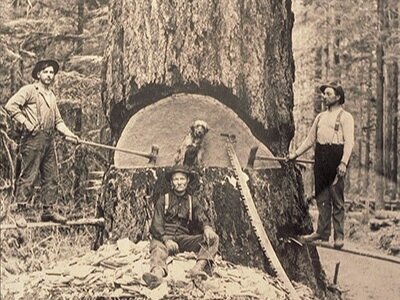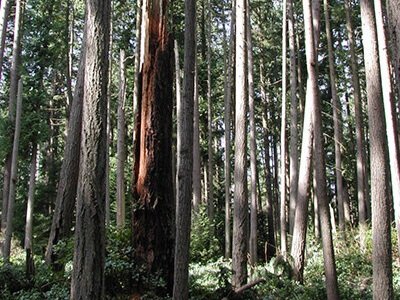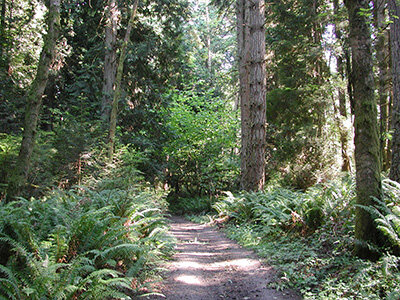The Forest
The 482-acre, forested park has substantial value as a natural area in the midst of a growing urban area. The trees use carbon dioxide for photosynthesis, ameliorating effects of carbon emissions from burning fossil fuels and related global warming. The forest also removes other pollutants from the air. It moderates temperature, reduces noise, provides wildlife habitat, and is a place for spiritual renewal and enjoyment of nature.
Patterns
Ecosystems change over time. Forests in the Puget Sound region experience a cycle of development and regrowth called forest succession. Prior to settlement of the area by Europeans, the dominant coniferous forests in Puget Sound were primarily disturbed by large-scale wildfires every few hundred years, which typically killed trees over many thousands of acres at a time. Graphic credit: USFS.
Regeneration
After large forest fires typical of our region, there were often many biological legacies: some living and many dead trees, typically large in size. These legacies contributed substantially to biological diversity in the regenerating forest. Old-growth forest conditions typically develop in this region when a forest is from 200 to 500 or more years old. What defines old-growth forest conditions is not age, however, but ecological condition. As a forest regenerates, it goes through many stages during succession.
Clear-Cut logging
Industrial clear-cut logging produced a much different result from natural disturbances. Few living or dead trees typically remained. Even when areas were selectively logged and live trees were left, the residual trees often were burned up in the many slash fires that characterized logging operations in the early twentieth century. Such fires were typically caused by sparks from railroad engines. The resulting regenerating forests were relatively uniform, with trees of similar size and often a single species, typically Douglas-fir at lower elevations. Such tree plantations have been shown to be biologically poor when compared to naturally regenerated forests.
Logging in the Park
Research into archival records indicates that the park was logged between 1898 and 1936. Fortunately, at least some of the park was selectively logged, leaving Douglas-firs now as large as 5 feet in diameter, 190 feet tall, and more than 300 years old. Most logging in the park was done with crosscut saws and axes, with the loggers standing on springboards supported in notches in the trees. Many stumps of the original Douglas-firs and Western Red Cedars can be found in the park today, and the springboard notches are visible on many. Comparison of 1936 aerial photos of the park with a map of the current trail system reveals that most of the current trails evolved from temporary trails used to "skid" (remove) logs, as well as early roads and trails used for accessing the timber and other purposes. Photo credit: Seattle Public Utilities.
Early Stages of Old Growth Forests
For decades after initial colonization following a natural disturbance, the density of trees may be very high, with intense competition among trees. As the trees put on foliage, the high density results in a closed forest canopy, with little light reaching the forest floor, little vegetation on the forest floor, poor habitat for animals, and very low biological diversity overall. As the forest ages, it “self-thins” as a result of mortality from competition among trees for light, water, and nutrients.
Middle Stages of Forest Development
As a forest matures further and trees become less dense, the primary source of mortality of trees shifts from competition to disturbances, such as wind, insects, and diseases, or the combination of those agents. This is the beginning of the development of the important processes of disturbance and decadence that characterize old-growth forests, resulting in broken tops of trees, dead and decaying standing trees (snags) and logs, and gaps created by dead or fallen trees. The death of, or damage to, trees and the formation of forest gaps can be considered the “engines of biodiversity.”
Developing Old Growth Forest Canopy
As the canopy opens and more light penetrates, the shade-tolerant species, such as western hemlock and western red cedar, start to grow faster, some eventually becoming part of the forest canopy. Thus, both large, old trees and variable tree density and sizes characterize old-growth forests. Also typical of old-growth forests is a high diversity of mosses, lichens, and other plants that grow as epiphytes on the surface of living trees and shrubs, and dead wood. This photo shows the development of epiphytes on 500-year-old old-growth forest near the Columbia River.
Bridle Trails on Way to Old Growth
The park is well on the way to developing into old-growth forest. Several severe windstorms in the last few decades have created many gaps and many snags and logs. The canopy is broken, and understory trees are starting to reach for the canopy. There is a lot of dead wood in many areas, and shrubs and herbaceous plants are present in areas with light penetration through openings in the canopy. There is also a considerable diversity of hardwood trees, such as Big Leaf Maple and Red Alder.







